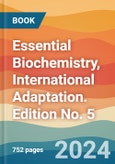Essential Biochemistry, 5th edition, comprises biology, pre-med, and allied health topics and presents a broad, but not overwhelming, base of biochemical coverage that focuses on the chemistry behind biology. This text relates the chemical concepts that scaffold the biology of biochemistry, providing practical knowledge and many problem-solving opportunities to hone skills. Key Concepts and Concept Check features help students identify and review important takeaways in each section.
This international adaptation contains up-to-date coverage of topics, including Ramachandran diagrams, lysozymes, steroid hormones, and ionophores. It also offers integrated coverage of SARS-CoV-2 and the impacts of COVID-19, relating it to the importance of an interdisciplinary response to a global pandemic. By focusing on strengthening the organization of the content as well as updating the end-of-chapter problems, this edition presents a brand-new experience to the reader.
Table of Contents
Preface xv
Part 1 Foundations
12 Metabolism and Bioenergetics 351
1 The Chemical Basis of Life 1
2 Aqueous Chemistry 27
Part 2 Molecular Structure and Function
3 Nucleic Acid Structure and Function 57
4 Amino Acid and Protein Structure 87
5 Protein Function 127
6 Enzymes: Classification and Catalysis 169
7 Enzyme Kinetics and Inhibition 203
8 Lipids and Biological Membranes 241
9 Membrane Transport 269
10 Signaling 299
11 Carbohydrates 327
Part 3 Metabolism
12 Metabolism and Bioenergetics 351
13 Carbohydrate Metabolism 381
14 The Citric Acid Cycle 419
15 Oxidative Phosphorylation 443
16 Photosynthesis 473
17 Lipid Metabolism 499
18 Nitrogen Metabolism 535
19 Regulation of Mammalian Fuel Metabolism 571
Part 4 Genetic Information
20 DNA Replication and Repair 597
21 Transcription and RNA Processing 641
22 Protein Synthesis 677








